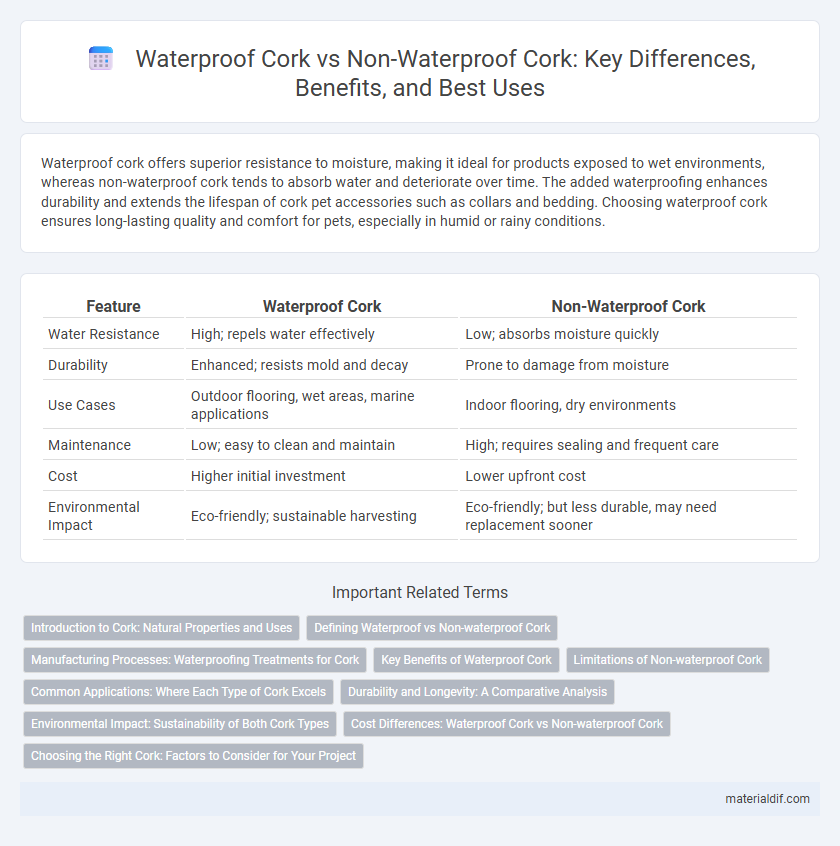Waterproof cork offers superior resistance to moisture, making it ideal for products exposed to wet environments, whereas non-waterproof cork tends to absorb water and deteriorate over time. The added waterproofing enhances durability and extends the lifespan of cork pet accessories such as collars and bedding. Choosing waterproof cork ensures long-lasting quality and comfort for pets, especially in humid or rainy conditions.
Table of Comparison
| Feature | Waterproof Cork | Non-Waterproof Cork |
|---|---|---|
| Water Resistance | High; repels water effectively | Low; absorbs moisture quickly |
| Durability | Enhanced; resists mold and decay | Prone to damage from moisture |
| Use Cases | Outdoor flooring, wet areas, marine applications | Indoor flooring, dry environments |
| Maintenance | Low; easy to clean and maintain | High; requires sealing and frequent care |
| Cost | Higher initial investment | Lower upfront cost |
| Environmental Impact | Eco-friendly; sustainable harvesting | Eco-friendly; but less durable, may need replacement sooner |
Introduction to Cork: Natural Properties and Uses
Waterproof cork is treated to enhance its natural resistance to moisture, making it ideal for applications in marine environments, flooring, and insulation where prolonged water exposure occurs. Non-waterproof cork retains its original cellular structure, offering excellent breathability and flexibility but requires protection from excessive moisture to maintain durability. Both types leverage cork's renewable, lightweight, and fire-resistant properties, widely used in construction, fashion, and sustainable packaging.
Defining Waterproof vs Non-waterproof Cork
Waterproof cork is treated or combined with sealants and resins to prevent water absorption, making it highly resistant to moisture and ideal for applications exposed to liquids or humidity. Non-waterproof cork, on the other hand, remains porous and absorbent, suitable for dry indoor uses such as flooring or bulletin boards where water resistance is not critical. The fundamental difference lies in the degree of water repellency, influencing durability, maintenance, and appropriate usage environments.
Manufacturing Processes: Waterproofing Treatments for Cork
Waterproof cork undergoes specialized manufacturing processes involving treatments such as polymer impregnation, silicone coating, and wax sealing to enhance its moisture resistance. These waterproofing methods create a protective barrier that prevents water absorption, maintaining cork's natural elasticity and durability. In contrast, non-waterproof cork lacks these treatments, making it more susceptible to water damage and swelling when exposed to moisture.
Key Benefits of Waterproof Cork
Waterproof cork offers superior resistance to moisture and humidity, making it ideal for applications in bathrooms, kitchens, and outdoor settings where regular cork would degrade or warp. Its enhanced durability extends the lifespan of cork products, reducing the need for frequent replacements and maintaining aesthetic appeal over time. Additionally, waterproof cork retains the natural insulating and anti-microbial properties of traditional cork, ensuring comfort and hygiene in both residential and commercial environments.
Limitations of Non-waterproof Cork
Non-waterproof cork exhibits significant limitations in moisture-prone environments due to its inability to resist water absorption, leading to swelling, degradation, and reduced durability. This vulnerability compromises its effectiveness in applications like flooring and insulation where consistent moisture exposure occurs. Waterproof cork variants overcome these issues by incorporating protective coatings or treatments, enhancing longevity and maintaining structural integrity under wet conditions.
Common Applications: Where Each Type of Cork Excels
Waterproof cork excels in applications requiring moisture resistance such as outdoor flooring, marine products, and wine stoppers because it prevents water absorption and maintains durability. Non-waterproof cork is typically used in indoor environments like bulletin boards, insulation panels, and cork flooring where water exposure is minimal and breathability is beneficial. Each type of cork offers distinct advantages by matching its water resistance properties to specific functional demands in construction, design, or packaging.
Durability and Longevity: A Comparative Analysis
Waterproof cork exhibits significantly enhanced durability and longevity compared to non-waterproof cork due to its treated surface that effectively repels moisture, preventing swelling, cracking, and mold growth. Non-waterproof cork, while naturally resilient, is more susceptible to water damage, leading to reduced lifespan and compromised structural integrity when exposed to damp environments. In applications such as flooring or outdoor furnishings, waterproof cork significantly outperforms non-waterproof variants by maintaining its physical properties and aesthetic appeal over extended periods.
Environmental Impact: Sustainability of Both Cork Types
Waterproof cork and non-waterproof cork both originate from the bark of the cork oak tree, a renewable resource that regenerates naturally without harming the tree, ensuring high sustainability. Waterproof cork undergoes additional treatment or coatings, which may introduce synthetic materials or chemicals potentially affecting its biodegradability and environmental impact. Non-waterproof cork remains more eco-friendly due to its minimal processing, maintaining the material's natural compostability and lower carbon footprint throughout its lifecycle.
Cost Differences: Waterproof Cork vs Non-waterproof Cork
Waterproof cork typically costs 20-30% more than non-waterproof cork due to its enhanced sealing treatments and protective coatings. The added expense reflects improved durability, resistance to moisture, and extended lifespan, making it a cost-effective choice for applications exposed to water. Non-waterproof cork offers a lower initial price but may incur higher maintenance and replacement costs in wet environments.
Choosing the Right Cork: Factors to Consider for Your Project
Waterproof cork offers enhanced resistance to moisture, making it ideal for outdoor applications and areas exposed to humidity, while non-waterproof cork suits indoor environments with minimal water exposure. Factors such as project location, expected moisture levels, and durability requirements determine the optimal choice between waterproof and non-waterproof cork. Evaluating these conditions ensures the selected cork material maintains longevity and performance tailored to specific project needs.
Waterproof cork vs Non-waterproof cork Infographic

 materialdif.com
materialdif.com